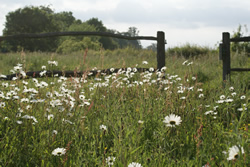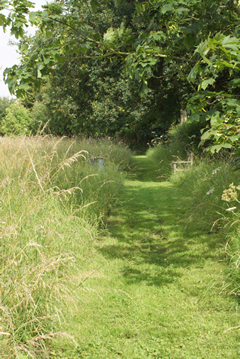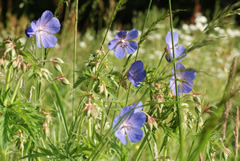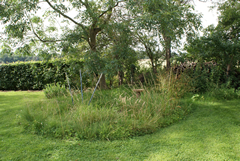 |

 |
 |
As temporary custodians of our land we care deeply that it is kept and managed in an environmentally considerate way, to ensure healthy soil, plants and wildlife, sustainable food chains and as diverse a wildlife family as the natural conditions should offer. We aim to set a good example of environmentally sustainable garden care.
Our land is just sufficiently large to provide a variety of habitats for wildlife; the traditional front and back garden you might find anywhere in England is supplemented by an acre of meadow grassland, hedgerows, mature trees, orchard, wildflower area, vegetable garden, woodpiles, shrubby thickets and a pond is planned. These areas are managed in a way that balances our needs - to retain some lovely views over our hedgerows, accessibility to all areas and a “cared for” feel to the garden - with the needs of wildlife to be left to themselves in areas that provide food, shelter and nesting to get on with being part of a healthy food chain in an oasis of environmental calm. Getting this balance between our contemporary perception of an aesthetic garden and the needs of nature is the key. We try to take the visitor from the contemporary end of the spectrum to the wildlife end and back again in the one garden.
The “contemporary” part hides a large number of man-made habitat features that aim to compensate for the lack of natural facilities. Hedgehog boxes, home-made and bought-in bird nesting boxes and roosting pockets, bumblebee nest, insect shelters, beetle bank and log piles provide nesting and shelter. Bird tables, feeders and numerous flowering shrubs provide food, while birdbaths, a tiny pond and other ground and raised watering facilities quench the thirsts of insects, mammals and birds. These all encourage wildlife within our sights so we can appreciate and record their presence and build up a profile of wildlife that can be sustained in the environment we steward.
In the 10 sq metre wildflower area, over a few years we have replaced the couch grass with a wildflower haven of about 32 wildflower species that peak in May and June, attracting insects and human beings alike. In the grassland meadow, ‘sub-habitats’ are being devised by rotating the area cut each year and by alternating the type of cut each year between mowing and hay-making. Small hayricks are being left as insect, spider and reptile habitats. In various places around the garden log piles provide shelter and a micro-habitat for insects, mosses and lichens.
For 15 years we have recorded sightings of wildlife on our two acres, initially on spreadsheets and subsequently on a database, and have so far identified 474 species. We know there are large numbers of insects and spiders yet to be identified and look forward to gradually expanding this list to include them. As we are only amateur naturalists, we are indebted to the lepidopterist, botanist, ornithologist and mycologist who have visited and “revealed” some of our hidden treasures.
But the main benefit we bring to wildlife and this environment is by what we do not do, and by what we do not have. No pesticides, no fertilisers, no herbicides, no fruit protection netting, no bonfires, no hosepipe watering, no unnecessary lawn mowing, no flower cutting, no hedge-cutting before August, no leaf blower, no artificial plant propagation outside natural seasonal cycles, no unsustainable plant species, no greenhouse, no cold frames, no cats, no peat, no waste. What we do not do determines our level of environmental stewardship, more than anything else.
And still the garden is healthy, plants flourish, nature abounds and it is a pleasant place for us to feel close to nature. There are no plant diseases but if any should arrive Mother Nature deals with them. Most importantly we protect our soil which is the foundation of a healthy environment and sustainable food chains.
